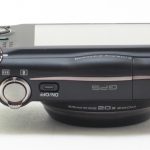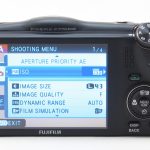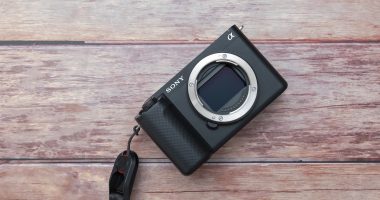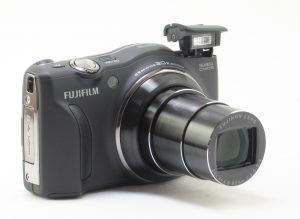 Lately, I’ve been focusing a lot on these new mirrorless system cameras such as the Sony NEX series and the Olympus PEN cameras. These have their advantages over DSLRs due to their size and flexibility however, they are still a bit too large to really fit comfortably in your pockets. The next step down from these cameras are what some companies describe as travel zooms. These are cameras that are slightly larger than compact cameras and include a lot of the feature sets you’d find in larger rangefinder style cameras. The main difference is that these feature absurdly huge zoom factors in and also absurdly small form factor. On such camera is FujiFilm’s new F770EXR Premium Travel Zoom camera.
Lately, I’ve been focusing a lot on these new mirrorless system cameras such as the Sony NEX series and the Olympus PEN cameras. These have their advantages over DSLRs due to their size and flexibility however, they are still a bit too large to really fit comfortably in your pockets. The next step down from these cameras are what some companies describe as travel zooms. These are cameras that are slightly larger than compact cameras and include a lot of the feature sets you’d find in larger rangefinder style cameras. The main difference is that these feature absurdly huge zoom factors in and also absurdly small form factor. On such camera is FujiFilm’s new F770EXR Premium Travel Zoom camera.
FujiFilm sent me one of their newest cameras in their F-series travel zoom lineup and I can honestly say that I have never been this excited about a hand held, compact style camera before. First off, the specs on this camera are much better than any compact or sub compact camera I have ever used. It features a new 16 megapixel EXR CMOS image sensor, a whopping 20x Fujinon optical zoom (25mm – 500mm equivalent), image stabilizer, full HD movie recording, and built-in GPS for geotagging all your photos.  We’ll go more in depth on all the features in the full review post later but in the meantime, I’ll be discussing my overall impression of the look and feel of this camera as well as the build quality.
Design & Body Layout
 The unit that FujiFilm USA sent to me was the black F770EXR. The camera is also available in red though I’m not sure if the red colored one has the soft touch coating on it like the black one does. The coating gives the camera a nice satin matte black look to it making the F770EXR easy to handle. I’m usually not a fan of soft touch coating due to the fact that they can deteriorate over time and leave a sticky feel to them but the coating on here seems very smooth and less rubbery then others I’ve encountered. I’m also not sure how the coating will hold up to accidental bumps and scratches, but I’m not about to test it out with this unit. Breaking up the matte black body are gunmetal accents that give some character to the F770EXR.
The unit that FujiFilm USA sent to me was the black F770EXR. The camera is also available in red though I’m not sure if the red colored one has the soft touch coating on it like the black one does. The coating gives the camera a nice satin matte black look to it making the F770EXR easy to handle. I’m usually not a fan of soft touch coating due to the fact that they can deteriorate over time and leave a sticky feel to them but the coating on here seems very smooth and less rubbery then others I’ve encountered. I’m also not sure how the coating will hold up to accidental bumps and scratches, but I’m not about to test it out with this unit. Breaking up the matte black body are gunmetal accents that give some character to the F770EXR.
The F770EXR is not a subcompact camera. It is small, but depending on the type of pants you wear, not always comfortably pocketable. This is due to the thickness around the lens area which is needed to accommodate such a high optical zoom factor. The camera will however fit comfortably in a jacket pocket or purse.
 Starting with the front of the camera, we can see that the F770EXR has a fairly generous hand grip and a very nice rubber insert for your fingers to grab hold of. This makes the camera very comfortable to hold with one hand and gives you the added peace of mind that it won’t just slip out of your hand due to an awkward holding position. The shape of the grip also adds to that comfort. Just above and right of the grip, you’ll find the AF assist light. Usually I like this light on the far right of the camera, but in this case, it’s high enough out of the way where my fingers do not block it. Next to that is the 20x optical zoom Fujinon lens with built in lens cover. Considering that this lens can deliver a maximum 500mm equivalent focal length, it is pretty small when fully compressed.
Starting with the front of the camera, we can see that the F770EXR has a fairly generous hand grip and a very nice rubber insert for your fingers to grab hold of. This makes the camera very comfortable to hold with one hand and gives you the added peace of mind that it won’t just slip out of your hand due to an awkward holding position. The shape of the grip also adds to that comfort. Just above and right of the grip, you’ll find the AF assist light. Usually I like this light on the far right of the camera, but in this case, it’s high enough out of the way where my fingers do not block it. Next to that is the 20x optical zoom Fujinon lens with built in lens cover. Considering that this lens can deliver a maximum 500mm equivalent focal length, it is pretty small when fully compressed.
Rotating the camera clockwise, this side of the camera doesn’t really contain much except for 1 small button. This button is used to eject the popup flash from its stored position. I really like this kind of design as it keeps the over all aesthetics of the camera nice and clean while allowing the position of the flash to be much higher up which I believe is supposed to help alleviate red-eye. From this position, you can also see just how thick the F770EXR really is which isn’t as apparent when looking at if from the front. You’ll notice too that the lens is surrounded by a thick metal ring which is a very thoughtful design as it also helps protect the lens element from bumps when compressed.
 Moving on to the back of the camera, this again is what you’ll be staring at most of the time when using the camera and is probably the most important part of the camera when it comes to design and layout. The rear is where most of the controls are located so a clean layout and buttons that are easily reached with your right thumb are very important for ergonomics and ease of use. Most of the rear is occupied by the large 3-inch, 460,000 dots, TFT color LCD monitor that displays 100% coverage.  I’m pretty sure it’s not glass though so you’ll want to use a screen protector with this if you’re worried about getting it all scratched up. To the right of the screen are all the buttons and dials you’ll need to use. On the top is the mode selection dial that is integrated into the thumb grip. Now this is something I don’t normally see on many compact cameras as most make you dig through the software to choose a mode. This means you can quickly switch modes when need be. Right below that is the direct movie record button and can be easily reached with your thumb.
Moving on to the back of the camera, this again is what you’ll be staring at most of the time when using the camera and is probably the most important part of the camera when it comes to design and layout. The rear is where most of the controls are located so a clean layout and buttons that are easily reached with your right thumb are very important for ergonomics and ease of use. Most of the rear is occupied by the large 3-inch, 460,000 dots, TFT color LCD monitor that displays 100% coverage.  I’m pretty sure it’s not glass though so you’ll want to use a screen protector with this if you’re worried about getting it all scratched up. To the right of the screen are all the buttons and dials you’ll need to use. On the top is the mode selection dial that is integrated into the thumb grip. Now this is something I don’t normally see on many compact cameras as most make you dig through the software to choose a mode. This means you can quickly switch modes when need be. Right below that is the direct movie record button and can be easily reached with your thumb.
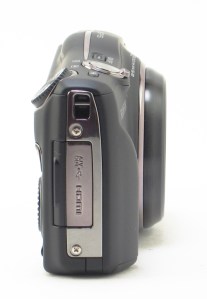 You’ll also notice the combination function dial/4-way button. I like this kind of design because not only do you get the 4-way function buttons, you also get the rotating dial to make quick adjustments to certain functions like ISO speed, aperture, and shutter speed when in specific modes. The F770EXR also includes an “F” button which is the photo mode button. I would equate this to the Q Menu on Lumix cameras that allow you to make adjustments to certain features quickly.
You’ll also notice the combination function dial/4-way button. I like this kind of design because not only do you get the 4-way function buttons, you also get the rotating dial to make quick adjustments to certain functions like ISO speed, aperture, and shutter speed when in specific modes. The F770EXR also includes an “F” button which is the photo mode button. I would equate this to the Q Menu on Lumix cameras that allow you to make adjustments to certain features quickly.
Rotating clockwise once again, this side of the camera is dominated by the terminal cover which is made of a hard plastic/rubber that seems to be pretty durable. It blends in nicely with the side of the camera and has a nice lip on it that makes it easy to open the cover up. Underneath the cover is a combination A/V and USB port as well as an HDMI port. Above the terminal cover is the strap eyelit which is deep and recessed. It might be a bit difficult for some to loop their wrist strap to this but once it’s in, it’s even harder to take off.  You can see from the angle too the generous thumb grip and finger grip which like I said above, makes the camera very comfortable to hold.
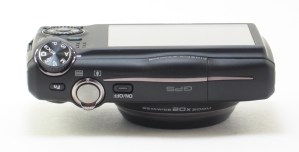 Looking at the top of the camera, you can see that there is a slight hump up there. This is partially to accommodate the large zoom lens, the popup flash, and I believe the GPS antenna. On the right of the image is the flash. It is concealed quite nicely when stowed away and you wouldn’t even know it was there. On the left in the photo is the shutter release button surrounded by the zoom control ring. This is fairly standard on most cameras of this type. There is a nice flush on/off switch which means that it will not be easily pressed accidentally making this a great design. Next to the shutter release button, there is an extra Fn button which you can assign to various different tasks that you want to access quickly such as changing ISO, enabling D-range, or even changing the “film” style. It’s a handy button and the placement makes it easy to access with your finger.
Looking at the top of the camera, you can see that there is a slight hump up there. This is partially to accommodate the large zoom lens, the popup flash, and I believe the GPS antenna. On the right of the image is the flash. It is concealed quite nicely when stowed away and you wouldn’t even know it was there. On the left in the photo is the shutter release button surrounded by the zoom control ring. This is fairly standard on most cameras of this type. There is a nice flush on/off switch which means that it will not be easily pressed accidentally making this a great design. Next to the shutter release button, there is an extra Fn button which you can assign to various different tasks that you want to access quickly such as changing ISO, enabling D-range, or even changing the “film” style. It’s a handy button and the placement makes it easy to access with your finger.
Final Thoughts
I really like the look of the FujiFilm F770EXR. It’s not tiny like a subcompact, but I’ll trade size for features and functionality with this category of cameras. In terms of travel zooms, the F770EXR is actually quite small and can fit in your jacket pocket easily. It can fit in your pants, but can be a bit tight depending on the type of pants you wear. I’m amazed really that they can stick a 500mm equivalent focal length lens on a camera this small and compact.
With a camera like this, ergonomics is very important and based on my initial handling of the camera, the F770EXR is very comfortable to handle with easily reached buttons and features. The soft touch coating on the camera isn’t exactly my favorite thing out there, but in this case, it feels very smooth and adds to the overall great handling experience of the camera.
In terms of build quality, the F770EXR seems fairly solid in my hand with a good weight to it. There are some issues however that I’ll point out. When the flash is out, there is a possibility of breakage especially if you were to accidentally get it caught on something or were to drop it on the flash. It does look a little flimsy and I’m not sure how it will hold up over time. Another issue is with the lens. When extended, lens feels a bit “wiggly” and not very stable. I’m not sure if this is an issue with other cameras in this category but you’ll probably want to make note of this when handling the camera. I’m not sure how the camera would handle a drop with the lens extended, but again, I’m not about to find out by testing out a drop.
Overall though, I like what I see so far and hope I’ll be as happy with real world usage.





